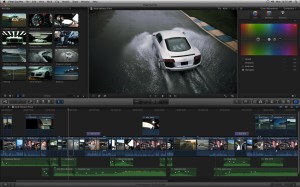
Local video producer and Drury instructor Brian Shipman has edited hundreds of projects and knows the ins and outs of choosing the perfect song to accompany moving images.
The Scoop sat down with Shipman, in his editing-bay cockpit in Shewmaker Communication Center and followed him on his pursuit for the perfect track.
 Here are five things to keep in mind when pairing music and video:
Here are five things to keep in mind when pairing music and video:
Music can become the project
“Music can take over a project if you’re not careful,” Shipman warns.
He explains that music is an art, as is the decision-making process of incorporating music. An editor has to be careful that the music doesn’t dominate the visuals.
“It’s like a loaded weapon,” Shipman says. “You just don’t want to point it at everything.”
Videos have feelings, too
According to Shipman, the most important aspect of music selection is the intended emotional enhancement of the piece: “You could take an ordinary shot of a farmer in a field. But then you lay down a soft violin behind it, and suddenly, it becomes romantic.” Emotion like this is what Shipman tries to evoke; he chooses the music to mirror the story’s feel.
“By themselves, they’re just video and music…,” he says. “(But when combined), it’s a whole new world.”
Pay attention to instrumentation
Shipman advises staying away from tracks that are heavy on synthesized guitar. He looks for separation among the instruments, and tracks with sonic clarity. Rock anthems tend to not be as dynamic as other arrangements and may even come off as too harsh, but there isn’t necessarily a go-to option.
“I don’t have a horns always go with this or strings always go with that,” Shipman says. “It happens when it happens.”
It takes time
Picking out tracks may seem like a quick and easy feat, but for Shipman, it’s a tedious process.
“I’ve been doing this for four days,” he says of his current project. “And I’ve spent all day today working on it.” He “auditions” each song, meaning he listens to hundreds a day and analyzes their emotional threshold, duration, and rock level.
He repeats the process until he finds a piece, and even then, it may not be perfect.
Key phrase: royalty-free
“Music is not free, and you can’t assume someone’s going to let you use it,” says Shipman.
One has to go through other media to find royalty-free music. Drury offers a virtual library subscription to FirstCom, which holds a variety of songs.
But there are some completely free and royalty-free downloads out there. “My students are coming back and finding lot of free music on the Web,” he says. “The key thing for students to know is if it says ‘royalty-free,’ you’re good to go.”
He also advises to know the information about the music used, even if it’s royalty-free. “I include that in my work, so I can cover my bases.” But what happens if someone doesn’t go by the law? “Apologize profusely. But sometimes, these things end up in court, you have to be careful.”
Be sure to check U.S. copyright law, and keep yourself aware.